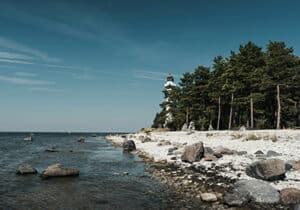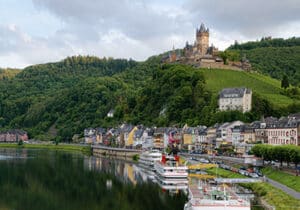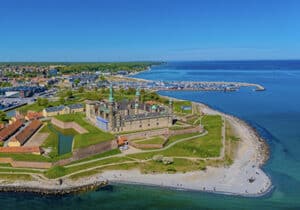Knowing what the cleanest country in the world is important for a variety of reasons. If you’re planning to move abroad, it can inform you on where you should settle long-term.
A clean country indicates a better quality of life for you and your family. It also offers you the opportunity to future proof your family’s lives for generations to come.
This article ranks the top 10 cleanest countries in the world, using data from the Environmental Performance Index (EPI), a globally recognized benchmark.
Top 10 Cleanest Countries in the World
1. Estonia
EPI Score: 75.7

This Baltic nation has transitioned away from oil shale to cleaner alternatives like wind, biomass, and solar power. Oil shale is not pumped like conventional oil, but a solid, organic substance converted into oil and gas. They have switched to cleaner alternatives like wind, biomass, and solar power.
Estonia also leads in waste management and sanitation infrastructure. The government has implemented progressive environmental regulations, and urban areas like Tallinn have seen major investments in green spaces and public transport electrification.
What sets Estonia apart is its digital governance strategy, which includes environmental monitoring and public accountability using real-time data.
2. Luxembourg
EPI Score: 75.1

The country has introduced sustainable urban development strategies and aggressively promotes green mobility. In fact, it became the first country in the world to offer free nationwide public transportation in 2020, which has significantly reduced car usage and urban emissions.
Luxembourg also scores highly on environmental health metrics like drinking water quality and sanitation.
Its high GDP enables substantial investments in renewable energy and ecosystem management, making it a small but mighty leader in environmental performance.
3. Germany
EPI Score: 74.5

Germany also has one of the world’s most effective recycling systems, supported by strict packaging laws and waste separation mandates.
Cities like Berlin and Hamburg offer green urban planning, with abundant bike lanes and low-emission zones.
In addition to strong biodiversity protection laws, Germany has led EU efforts to meet carbon neutrality goals, demonstrating both national and international environmental leadership.
4. Finland
EPI Score: 74.5

It ranks among the best globally for air and water quality, thanks to low levels of industrial pollution and excellent environmental management practices.
Finland is also a leader in clean technology innovation, investing heavily in sustainable timber production, circular economy models, and green building standards.
The country’s education system incorporates environmental safekeeping from a young age, and public attitudes toward sustainability are deeply embedded in Finnish culture.
5. United Kingdom
EPI Score: 72.6

The UK’s Clean Air Strategy has led to improvements in urban air quality, particularly in cities like London, which has introduced ultra-low emission zones.
Conservation programs have helped restore habitats for native wildlife, and marine protection zones have been expanded.
With strong policy frameworks and innovative urban planning, the UK sets a strong example in sustainable development.
The UK offers dual citizenship, meaning you can secure this clean country’s sought-after passport while maintaining your original citizenship for that extra layer of security.
6. Sweden
EPI Score: 70.3

Sweden also employs advanced waste-to-energy systems, incinerating garbage to generate electricity while minimizing landfill use.
Cities like Stockholm are designed with sustainability in mind, featuring widespread access to clean public transport and pedestrian-friendly zones.
Sweden’s green tax shift, that imposes higher taxes on pollution and lower ones on labor, has been effective in reducing environmental harm while simultaneously fostering economic growth.
7. Norway
EPI Score: 69.9

The nation has also become a global leader in electric vehicle adoption, with EVs comprising over 80% of new car sales.
Norway invests significantly in ocean conservation, protecting its vast marine territory and prioritizing sustainable fisheries. The government has created one of the world’s largest sovereign wealth funds, which excludes environmentally harmful investments.
Clean air, clean water, and green landscapes are not just a byproduct of geography, they’re protected by government policy and public consensus.
8. Austria
EPI Score: 68.9

Nearly 60% of Austria’s electricity comes from renewable sources, primarily hydroelectricity.
The country is also known for its efficient waste management system, with a recycling rate exceeding 55%.
Austrian cities, particularly Vienna, are noted for green spaces, excellent public transport, and energy-efficient buildings.
Furthermore, Austria’s agricultural sector is heavily invested in organic farming and biodiversity protection, reducing the ecological footprint of food production.
9. Switzerland
EPI Score: 67.8

Recycling is a national habit, and energy efficiency is encouraged in everything from public buildings to household appliances.
Switzerland’s alpine landscape is carefully protected, with strict limits on industrial development and land use.
The country also excels in green finance, offering incentives for sustainable investments and businesses. If you’re looking to gain entry into this sought-after clean country, you should look into applying for a Golden Visa program.
10. Denmark
EPI Score: 67.7

Danish cities like Copenhagen are global leaders in bike-friendly infrastructure, low-emission zones, and sustainable architecture.
Public transportation is clean and efficient, and waste is converted to energy at state-of-the-art facilities.
Denmark’s climate policies are among the most ambitious in the EU, aiming for complete carbon neutrality by 2050.
If you’re interested in combining environmental values with global mobility, explore the best citizenship by investment programs to gain access to clean, sustainable nations.
Measuring the Cleanest Countries: How EPI Ranking Works
We used the Environmental Performance Index (EPI) to gather these rankings. It’s a system developed by Yale University and Columbia University in collaboration with the World Economic Forum.
It evaluates the environmental performance of countries using a set of quantitative indicators across two major categories:
1. Environmental Health
This objective measures how well countries protect human health from environmental harm. It focuses on factors directly affecting people’s quality of life, like air quality, sanitation, drinking water and presence of heavy metals.
2. Ecosystem Vitality
This factor evaluates how well countries protect natural ecosystems and manage resources sustainably. The main subcategories focus on climate change mitigation, biodiversity, forests, fisheries, agriculture, water resources, and air pollution.
Frequently Asked Questions about the Cleanest Country in the World
Which countries are ranked the cleanest in the world?
Estonia, Denmark, and Switzerland top the Environmental Performance Index for their strong environmental policies, low pollution, and high use of clean energy.
Which factors determine the cleanest country in the world?
Cleanliness is measured using indicators like air and water quality, waste management, renewable energy usage, and environmental health.
Which country has the best environmental policies?
Sweden is often praised for its progressive environmental policies, especially in renewable energy, recycling, and sustainable transport.
Which country has the cleanest water?
With water sourced from protected lakes and natural springs, Norway is known for having some of the cleanest and safest drinking water worldwide.
Does Japan count as one of the cleanest countries in the world?
Yes. It is widely considered to be a clean country even though it doesn’t always rank officially. The nation has exceptionally clean public spaces despite limited public waste bins because there is a cultural emphasis on cleanliness and recycling.
Which country ranks as having the cleanest air quality globally?
In 2024, Iceland was given the distinction of having the cleanest air in the world, with an average PM2.5 concentration of just 3.4 µg/m³. This means there is an exceptionally low level of fine particulate matter indicating pristine air quality.



